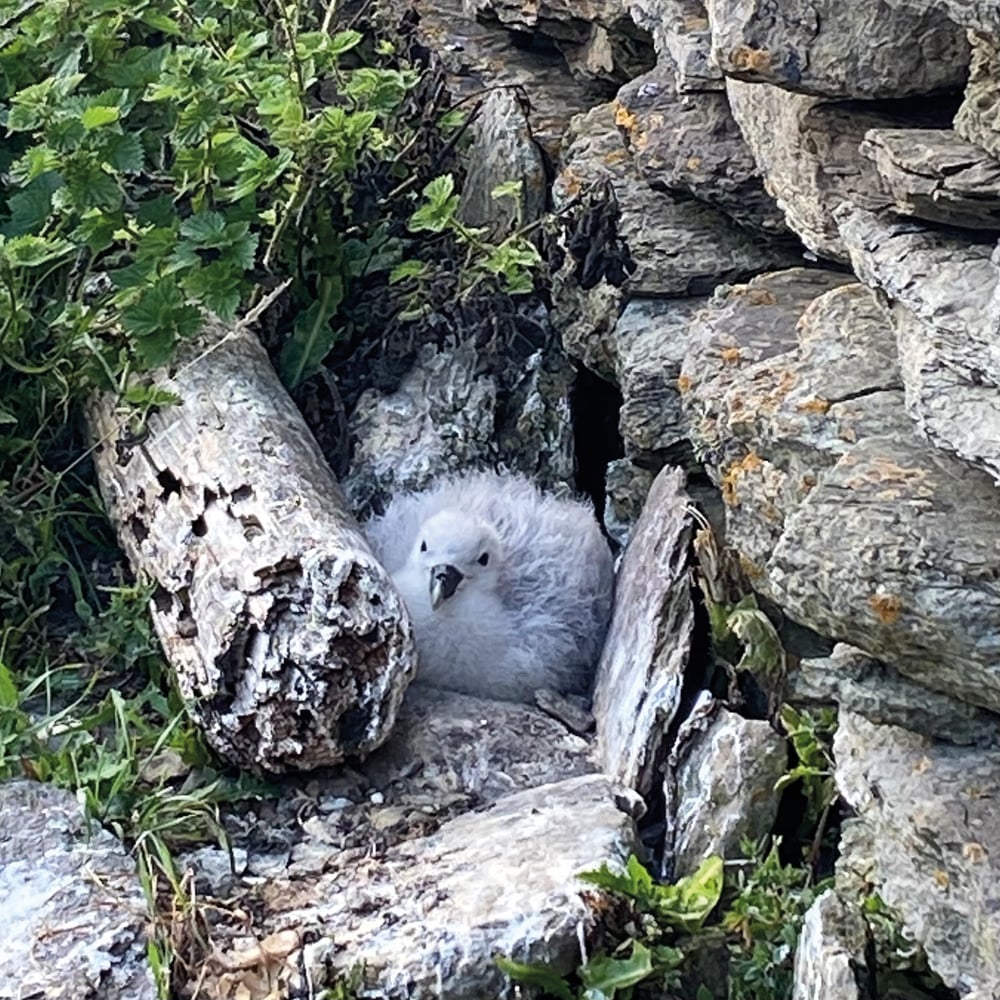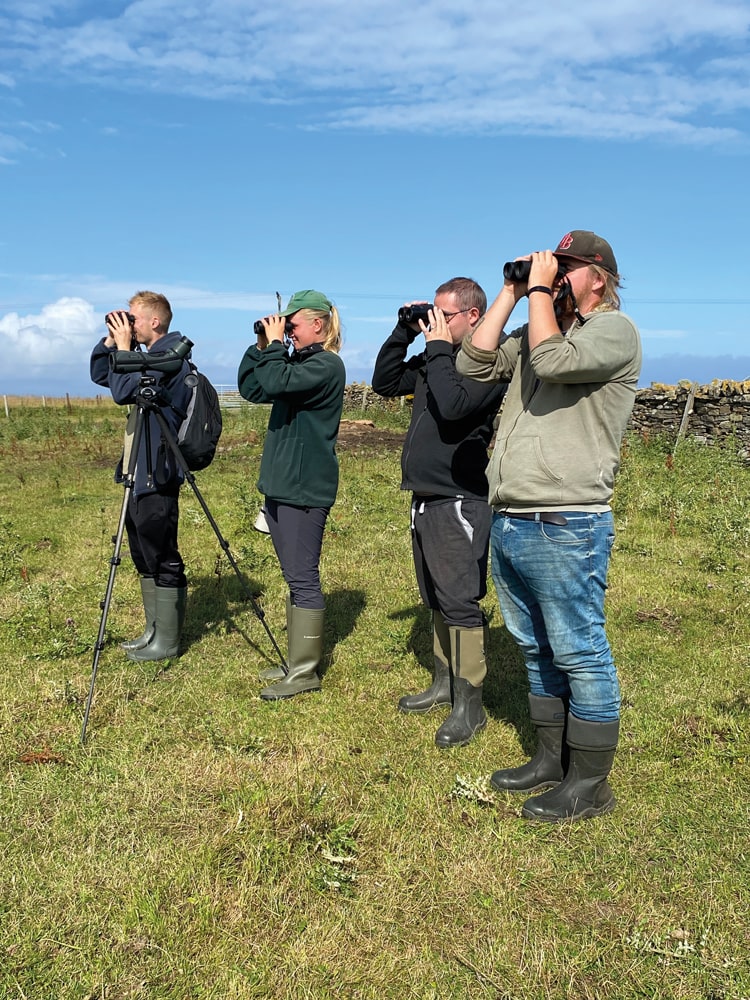Orkney’s northernmost outpost, the tiny island of North Ronaldsay – affectionately nicknamed North Ron – enjoys a glorious wind-blasted isolation. Next stop north is Fair Isle, while east is Norway. When locals talk about ‘the mainland’ they mean mainland Orkney, which you pass through to get here by ferry or plane. Mainland Scotland feels so remote it’s dubbed ‘doon sooth’. England seems like a faraway foreign land.

The three-mile-long, two-mile- wide island has a population of just 60 people and no main town. It is famed for its semi-feral North Ronaldsay sheep, which graze on seaweed on the foreshore, walled off by a 13-mile-long drystone dyke since 1832. The breed has probably lived on Orkney since Neolothic times, but only survived on North Ronaldsay. A diet of seaweed gives the meat a fabulous umami flavour and, in summer, crofters and their families gather to shear their sheep in stone walled ‘punds’ or pounds. There’s a sheep festival to celebrate the island’s ovine history. There’s plenty more to see too, from seals and orcas to silver-sanded beaches, a bird observatory – North Ron is a migratory birds’ staging point – and a lighthouse dating from 1854, the UK’s tallest land-based beacon. Birders, stargazers and walkers all enjoy the island from spring to late autumn, and at the end of the season you might even catch sight of the Northern Lights.
SATURDAY AM
10 am Woolly wonders
I’ve only just arrived but already I’m enchanted by the island’s diminutive sheep, which are everywhere, so I kick off my visit with a tour of the mill that spins their wool. It stands near Dennis Head, on the island’s northern tip, inside the former engine rooms of the candy-striped lighthouse. I meet manager Jane Donnelly, who helped acquire the artisan-scale mill machinery on Prince Edward Island in Canada. I’m guided by millworker Helen Galland, who shows me clattering machines that transform raw wool into single ply threads. Helen weaves the wool into throws and lampshades on a loom at home, while island women knit jumpers and hats; it’s all on sale in the shop next door. Given the wind that’s blowing, one of those hats seems just the ticket (£5 per adult, 07951 449136, northronaldsayyarn.co.uk).

SATURDAY
1pm Mutton magic
Louise Palmer only took over the Lighthouse Cafe in July 2021, but it’s already famous all across Orkney for her heritage-grain sourdoughs, Westray crab sandwiches and gorgeous cakes. I plump for her North Ronaldsay mutton pie, served with butter-browned tatties flecked with seaweed, £12.50. Louise tells me that she includes sheep fat in the pastry and I can taste it – utterly delicious. Contrary to the perceived view on mutton, the flavoursome meat cuts like butter. Dessert is a slice of buttermilk and sugar plum tart, digested with a stroll around the exhibition on island life next door (11.30am-5pm, Weds-Sun, 01857 633297, northronaldsay.co.uk).

3pm Beacons of light
Next on my must-see list are the island’s two lighthouses, built in response to the devastating number of shipwrecks off its treacherous rocks from the 1700s onwards. They include the Svecia, a Swedish East Indiaman that went down in 1740. Ninety crew were lost, along with a cargo of gold coins, dyewood and porcelain. Billy Muir, who has been the lighthouse keeper for 52 years, tells me the story of how islanders glimpsed the sun reflecting off an officer’s gold buttons but were unable to save him.
Why two lighthouses? Sadly the first, lit in October 1789, proved a disaster as its reassuring oil lamps actually lured ships onto the rocks. So, a second, taller one, was built on dry land out of brick, 65 years later. In non-pandemic times Billy escorts visitors up the lighthouse’s 176 steps to the top, from where you get views over Orkney and as far as Shetland (book tours by ringing Billy on 07703 112224). I make do with his colourful stories, and then wander east along the pebbled beach to the old stone lighthouse. Following a win in BBC TWO’s Restoration programme in 2006, scaffolding was put in place for a major restoration, however, it never happened. So the edifice has since become wedded to its scaffolding shell, like a monster millipede.

5pm Taking to two wheels
After hiring a bike from the Lighthouse Café, I pedal southwards along a single-track road lined with wild rhubarb and serenaded by crested lapwings with their haunting ‘peewit’ cries. I stop to admire the massive flagstones that roof the island’s ancient crofts, longhouses built out of the local golden sandstone. First stop is the New Kirk, which houses the island’s fascinating photographic archive, assembled as a millennium project (northronaldsaytrust.com). Passing the Old Kirk next door, I reach the Standing Stone or ‘Stan Stane’, a 13ft-high needle with a hole pierced through it. Some believe it may have been used as a sighting aid, or as a primitive sundial, although some locals tell me they prefer the story that a giantess pushed her finger though it… (northronaldsay.co.uk/standing-stone).

SUNDAY AM
10am Bird bonanza
North Ronaldsay is one of the best locations around Britain to see birds, particularly those migrating birds that stop off on their way through during spring and autumn. In 1987 North Ronaldsay Bird Observatory was set up here to monitor them. I’m lucky enough to be invited to accompany assistant warden George Gay – and two plucky volunteers – ringing fulmar chicks. These nest below the stone dyke encircling the island, and thanks to fulmars’ habit of vomiting up their oily fishy breakfast to ward off intruders, the job demands stamina and thick trousers (no surprise that their name comes from the Norse ‘foul maar’ meaning ‘foul gull’. Out on the tar-black rocks around the Observatory we also see black guillemots, cormorants, and glistening white Arctic terns. Book bird tours through the Observatory (01857 633200, nrbo.org.uk).

SUNDAY PM
1pm Eats on Nouster beach
Provisioned by the Observatory shop, I munch my lunch outdoors, beneath the dyke on Nouster Beach, while watching salmon-plumed sanderlings skimming across the sand and common and grey seals basking on the sun-warmed rocks.
2pm An afternoon stroll
Rounding the headland to the east of the island, I spot the Broch of Burrian, a coastal Iron Age fort. I return via the ruined mill, once used to grind bere, a type of barley cultivated on Orkney on account of its short growing season. My last highlight is turreted Holland House, built by the Traill family, the island’s lairds, who bought North Ronaldsay in 1727 and remain there still.

6pm Sunday Roast
What better way to end than with a sheep roast back at the Observatory? Guests gather in the conservatory – the closest thing the island has to a pub. We sit at one long table and finish off our meal with a rhubarb crumble, topped with warden Alison Duncan’s homemade rhubarb ice cream – a fitting finale to a cracking weekend.

NEED TO KNOW
WHERE TO STAY IN NORTH RONALDSAY
- coast stayed at the North Ronaldsay Bird Observatory, which offers simple but comfortable accommodation (7-room hotel, 10-bed hostel or camping) and ornithological activities. Lunch available in the Obscafe. In the evening, guests dine communally in the conservatory and Orkney beers are on sale in the bar. (01857 633200, nrbo.co.uk, check the website for rates).
- coast also stayed at stylishly refurbished self-catering croft Verracott, with its traditional flagstone roof and floors. There’s a double bedroom, plus an antique box-bed in the sitting room. It’s a two-minute walk to the island’s wild west coast, and you can warm up beside woodburners in the sitting room and kitchen (07710 519753 verracott.com, from £550 per week).
- The dreamy view over Nouster Beach is the draw at the handsome two-storey stone crofthouse called Nouster, just minutes from the pier and the Observatory. There are two bedrooms and a conservatory where you dine while taking in the birdlife (01857 633253, howar.co.uk, £300-£340 per week).

HOW TO GET TO NOTH RONALDSAY
FERRY: In the summer, Orkney Ferries runs a twice-weekly service on Tuesdays and Fridays from Kirkwall, arriving at Nouster Pier near the Observatory. In the winter, there’s just one ferry a week, on Saturday (orkneyferries.co.uk).
FLY: Loganair runs three flights daily (fewer in Nov-Feb) from Kirkwall on its eight-seater Islander plane (loganair.co.uk).
To plan a trip, browse orkney.com, nrsheepfestival.com and northronaldsaytrust.com.
Get more inspiration for your next weekend away – explore more weekend guides or pick up the latest issue of coast magazine.




















